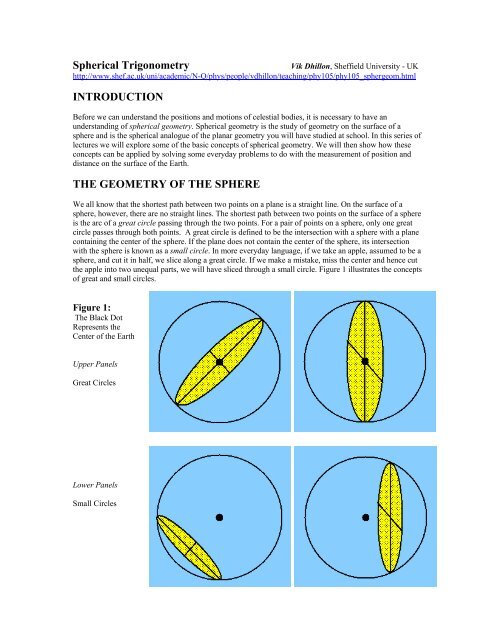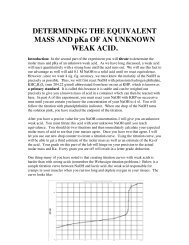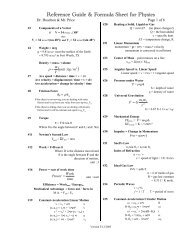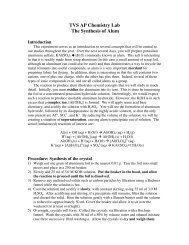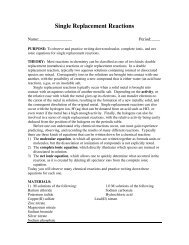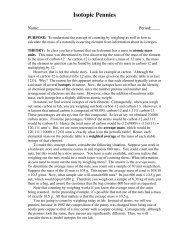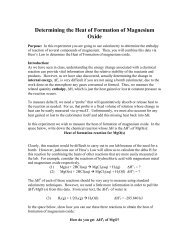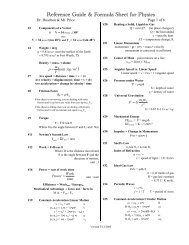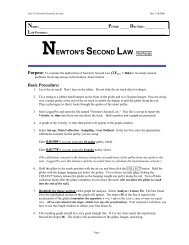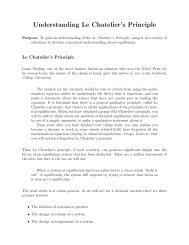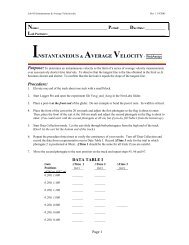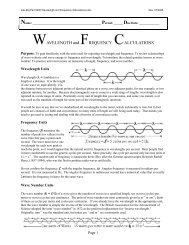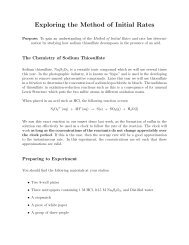Spherical Trigonometry INTRODUCTION THE GEOMETRY OF THE ...
Spherical Trigonometry INTRODUCTION THE GEOMETRY OF THE ...
Spherical Trigonometry INTRODUCTION THE GEOMETRY OF THE ...
Create successful ePaper yourself
Turn your PDF publications into a flip-book with our unique Google optimized e-Paper software.
<strong>Spherical</strong> <strong>Trigonometry</strong>Vik Dhillon, Sheffield University - UKhttp://www.shef.ac.uk/uni/academic/N-Q/phys/people/vdhillon/teaching/phy105/phy105_sphergeom.html<strong>INTRODUCTION</strong>Before we can understand the positions and motions of celestial bodies, it is necessary to have anunderstanding of spherical geometry. <strong>Spherical</strong> geometry is the study of geometry on the surface of asphere and is the spherical analogue of the planar geometry you will have studied at school. In this series oflectures we will explore some of the basic concepts of spherical geometry. We will then show how theseconcepts can be applied by solving some everyday problems to do with the measurement of position anddistance on the surface of the Earth.<strong>THE</strong> <strong>GEOMETRY</strong> <strong>OF</strong> <strong>THE</strong> SPHEREWe all know that the shortest path between two points on a plane is a straight line. On the surface of asphere, however, there are no straight lines. The shortest path between two points on the surface of a sphereis the arc of a great circle passing through the two points. For a pair of points on a sphere, only one greatcircle passes through both points. A great circle is defined to be the intersection with a sphere with a planecontaining the center of the sphere. If the plane does not contain the center of the sphere, its intersectionwith the sphere is known as a small circle. In more everyday language, if we take an apple, assumed to be asphere, and cut it in half, we slice along a great circle. If we make a mistake, miss the center and hence cutthe apple into two unequal parts, we will have sliced through a small circle. Figure 1 illustrates the conceptsof great and small circles.Figure 1:The Black DotRepresents theCenter of the EarthUpper PanelsGreat CirclesLower PanelsSmall Circles
SPHERICAL TRIANGLESAnother concept we should all be familiar with from planar geometry is the triangle. If we wish to connectthree points on a plane using the shortest possible route, we would draw straight lines and hence create atriangle. By analogy, if we wish to connect three points on the surface of a sphere using the shortestpossible route, we would draw arcs of great circles and hence create a spherical triangle. To avoidambiguities, a triangle drawn on the surface of a sphere is only a spherical triangle if it has all of thefollowing properties:• The three sides are all arcs of great circles.• Any two sides are together longer than the third side.• The sum of the three angles is greater than 180°.• Each individual spherical angle is less than 180°.Hence, in Figure 2, triangle PABD is not a spherical triangle (as the side AB is an arc of a small circle), buttriangle PCDP is a spherical triangle (as the side CD is an arc of a great circle). You can see that the abovedefinition of a spherical triangle also rules out the "triangle" PCEDP as a spherical triangle, as the vertexangle P is greater than 180° and the sum of the sides PC and PD is less than side CED.Figure 2:Triangle PCDP is a spherical TriangleTriangle PABP is not a <strong>Spherical</strong>Triangle because side AB is notan arc that is part of a Great CircleTriangle PCEDP is not a <strong>Spherical</strong>Triangle because the angle at P isgreater than 180º and because thelength of side CED is greater than thesum of the other two sides, PC andPD.It is important to realize that thelengths of the sides of a sphericaltriangle are expressed in angularmeasure. This follows from the factthat the length of an arc s whichsubtends an angleat the center of a circle of radius r is given bys = ( / 360) • 2 rwhere is measured in degrees and s is given in the same length units used for r.
Recalling that 2radians = 360°, allows us to rewrite that expression ass =rwhere is now measured in radians and s is still given in whatever length units are used for r. Given thatspherical triangles are all made up of great circle arcs, and all great circle arcs on a sphere are of the sameradius, it is convenient to take the radius of the sphere as unity and then writes =which says that that we can express the length of a side of a spherical triangle as the angle (in radians) itsubtends at the center of the unit sphere. If s is one-quarter of the circumference of a great circle, thens = (2 / 4) radians = ( / 2) radians (there is no ambiguity if it is then expressed, for convenience, as 90°)SPHERICAL TRIGONOMETRYTo perform calculations with planar triangles it isnecessary to use the formulae of planar trigonometry,which you will have met before. Similarly, to performcalculations with spherical triangles it is necessary touse the formulae of spherical trigonometry, which aregiven below. Figure 3 shows a spherical triangle,formed by three intersecting great circles, with arcs oflength (a, b, c) and vertex angles of (A, B, C).Figure 3:A spherical triangle with arcs of length(a, b, c) and vertex angles of (A, B, C).Note that the angle between two sides of a sphericaltriangle is defined as the angle between the tangents tothe two great circle arcs, as shown in Figure 4 forvertex angle B.Figure 4:The vertex angle B is defined as the anglebetween the tangents to the two great circlearcs, a and c.
Two coordinates, latitude and longitude, can be used define the location of any point on the Earth’s surface,as illustrated in Figure 7.The longitude of a point is measured east or west of the Greenwich Meridian along the equator. Thelongitude is the angular distance between the local meridian (which passes through the point) and theGreenwich meridian (which passes through the Royal Greenwich Observatory in London). Because theEarth is rotating, it is possible to express longitude in time units as well as angular units. The Earth rotatesby 360° in about 24 hours. Hence, the Earth rotates 15° of longitude in 1 hour, 1° of longitude in 4 minutes,1´ (one minute of longitude) in 4 seconds and 1” (one second of longitude) in 1/15 second.The latitude of a point is the angular distance north or south of the equator, measured along the meridianpassing through the point. A related term is the co-latitude, which is defined as the angular distancebetween a point and the closest pole as measured along the meridian passing through the point. In otherwords, the co-latitude = 90° − latitude.Figure 7:Using Latitude and LongitudeDistance on the Earth's surface is usually measuredin nautical miles, where one nautical mile is definedas the distance subtending an angle of one minute of arc at the Earth's center. A speed of one nautical mileper hour is known as one knot and is the unit in which the speed of a boat or an aircraft is usually measured.Note that because the Earth is not a true sphere (it is actually a geoid) the actual measurement of positionand distance on the Earth's surface is more complicated than outlined above but the above description isaccurate enough for our purposes.
EXAMPLE PROBLEMS1.The latitude and longitude ofSheffield are 53°23’12” N and 1°28’07” W, respectively.The latitude and longitude ofSydney are 33°55’24” S and 151°17’03” E, respectively.(Note in these calculation, North Latitude and West Longitude are both positive, while SouthLatitude and East Longitude are both negative)What is the difference in the latitude of the two cities in decimal degrees?Difference in latitude = 53°23’12” − (− 33°55’24”) = 87°18’36”Difference in latitude = 87° + (18/60)° + (36/3600)° = 87.3100°What is the difference in the longitude of the two cities in decimal degrees?Difference in longitude = 1°28’07” − (− 151°17’03”) = 152°45’10”Difference in longitude = 152° + (45/60)° + (10/3600)° = 152.7528°What is the difference in longitude in hours, minutes and seconds of time?Difference in longitude = 24 • 152.7528 / 360 = 10.18352 hDifference in longitude = 10 h (0.18352 • 60) m = 10 h 11.0112 mDifference in longitude = 10 h 11 m (0.0112 • 60) s = 10 h 11 m 0.67 sWhat are the co-latitudes of Sheffield and Sydney?Latitude of north pole = 90° Nco-latitude of Sheffield = 90° − 53°23´12´´ = 36°36´48´´Latitude of south pole = 90° Sco-latitude of Sydney = 90° − 33°55´24´´ = 56°4´36´´2.Given that the mean radius of the Earth as 6370 km, convert the nautical mile and the knot intomiles and mph.Circumference of the Earth = 2 • 6370 kmNumber of arc-minutes in 360° = 360 • 60 = 21600’Length of arc subtended by 1’ = 2 • 6370 / 21600 = 1.85 kmTherefore, 1 nautical mile = 1.85 km = 1.85/1.61 miles = 1.15 milesand, 1 knot = 1.85 km/h = 1.15 mph.
3.How much longer will it take to fly from Sheffield to Petropavlovsk in Russia along the parallelcompared to the great circle route? Assume that Sheffield and Petropavlovsk are at the samelatitude (53°23´ N), the longitude of Sheffield and Petropavlovsk are 1°28´ W and 158°42´ E,respectively, and the plane is flying at 500 knots.Figure 8:Two flight paths from Sheffield toPetropavlovsk in RussiaLet A and B in Figure 8 represent Sheffield and Petropavlovsk, so that the parallel route is denoted by thered arc ARB and the great circle route is denoted by the yellow arc AYB. If the meridians PAC and PBD aredrawn from the north pole P through A and B to the equator CD, triangle PAYBP is a spherical triangle.Applying the cosine formula, we may then writecos AYB = cos AP cos BP + sin AP sin BP cos APB ; where AP = BP = 90° − 53°23’ = 36°37’ = 36.6167°and APB = 1°28’ − (− 158°42’) = 160°10’ = 160.1667°.Substituting these numbers into the cosine formula givescos AYB = (cos 36°.6167) 2 + (sin 36°.6167) 2 cos 160.1667° ; thus AYB = 71°.9663 = 71°58´ = 4318’.The great circle distance between Sheffield and Petropavlovsk is therefore 4318 nautical miles and hence itwill take 4318/500 = 8.636 h = 8 h 38 m to complete the journey via the yellow (upper) arc in Figure 8.The distance between Sheffield and Petropavlovsk along the parallel of latitude 53° 23´ N (a measurementoften referred to as the departure) can be calculated as follows:The circumference of the parallel at latitude 53°23´ N = 2 r, wherer = R cos AOC, AOC = 53°23´ = 53.3833° and R = radius of the Earth = 3443 nautical miles.The red arc ARB in Figure 8 covers only a fraction of this circumference, where the fraction is given byAQB/360° and AQB is given by the difference in longitude of A and B. So,ARB = (160°.1667/360°) • 2• 3443 • cos 53°.3833 = 5741 nautical miles.Hence it will take 5741/500 = 11.482 h = 11 h 29 m to complete the journey along the red (lower) arc inFigure 8. Thus, the journey between Sheffield and Petropavlovsk is 2 h 51 m quicker along the great circleroute than along the parallel.


